Banteay Srey is a butterfly farm outside Siem Reap. The center was started by a Danish man, to create work for local families by cultivating and exporting butterflies and cocoons.
An enclosed atrium is packed with butterflies, at all stages of the butterfly’s life cycle.
Most beautiful and unexpected to us was the room of cocoons where we watched as “newborn” butterflies were emerging from their pupa stage. Some were just emerging and others had their bright wings drying and opening. Some butterflies were hanging bat like, upside down, with still folded wings.
The butterfly keeper showed us how to gently nudge the new butterflies, onto a finger, to be released into the flower rich environment.
 |
| At a mature stage, the cocoons become translucent. You can start to see the designs on the wings before they open. |
 |
| The rows of cocoons look like jewels hanging in the sunlight. |
Having a new born butterfly perch on my finger, a few inches from my nose while I wait for it to fly off, has all the drama of life itself. I can feel the touch of the butterfly’s “feet” as it prepares to take off.
Butterflies have such amazingly bright colors and designs, no two ever alike, yet they live for only two weeks!
 |
| A young butterfly “keeper” shows us the worms before they start their cocoons. |
 |
| Once the butterflies are released back into the environment, they head straight for the flowers! |
At the butterfly farm, we learn of a nearby silk farm / village.
Silk is of course a mainstay of economic activity amongst multiple nations along the infamous Silk Road that connected the Far East with Europe for several hundred years. If the beauty of butterflies is ephemeral, the beauty of silkworms lies in the end product – the silk of course!
As far back as recorded history there are images (sculpted in rock as in the case of Angkor) of men and women in traditional clothing which typically used silk as the main fabric.
The silk farm starts with the mulberry trees.
This brings back memories for me, (Peta), growing up on a hillside in Johannesburg, South Africa and having collected silkworms with my siblings, which we then fed mulberry leaves and delighted in watching their metamorphosis in their shoe boxes, from silkworm to moths.
It is so much fun to see such a large population of silkworms, cocoons all playing a part in Vietnam’s critical silk industry.
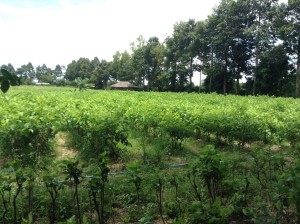 |
| Where it all starts…. rows and rows of Mulberry trees |
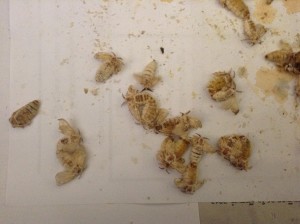 |
| Moths mating… which re starts the cycle from the eggs that they lay. |
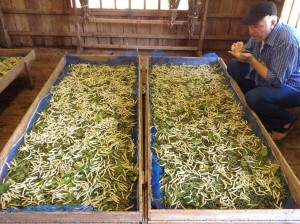 |
| Ben meets silk worm, up close and personal… |
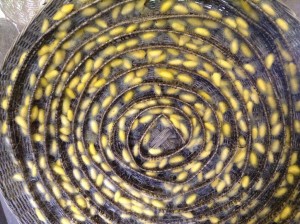 |
| The golden color you see is the start of silk, created by the saliva of the silkworm to form a cocoon. |
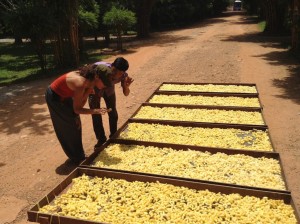 |
| The golden cocoons drying in the sunlight. Each cocoon is a tightly spun single golden thread of silkworm spit. |
Once the golden cocoons are dry, they go in boiling water, where, as shown in video below, a skilled artisan “picks up” the thread from multiple cocoons — 45 threads from 45 cocoons combine to make a single silk thread.
 |
| Raw silk threads hanging to dry before being cleaned of impurities. |
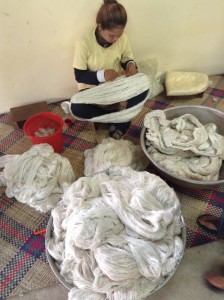 |
| Making bundles of the white silk before being dyed. |
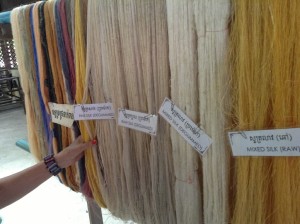 |
| Silk that has been dyed with natural dye colors from plants and flowers. |
Love the strong palette of organic dye colors…
There are over 20 large looms, all staffed with master weavers. Each machine requires an extensive set up of wooden frames, which correspond to a single fabric that will be woven for an entire month by the skilled craftsman.
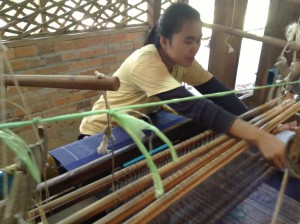 |
| The looms form an impressive operation. |
The weavers are paid “by the piece”, so the level of activity and productivity in the loom room is high.


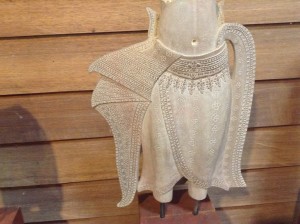
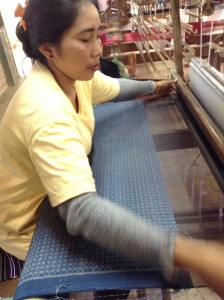
Beautiful pics of silk production. I’ve tried to find a lot of these behind the scenes pictures, and I’m going to add these to my bookmarks. Thanks for showing how its made.